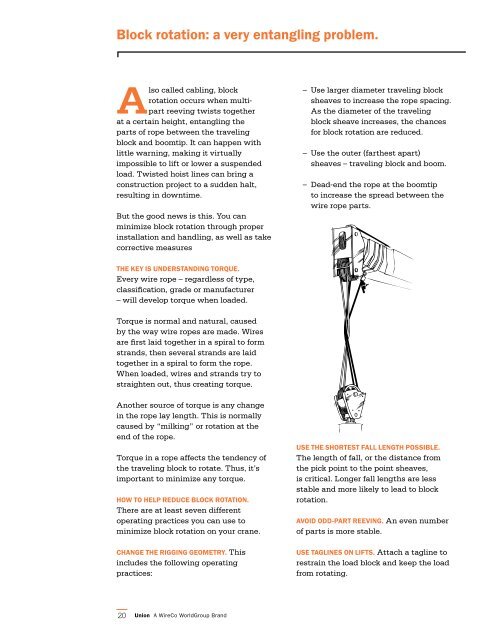Crane User's Guide - Union Wire Rope
Crane User's Guide - Union Wire Rope
Crane User's Guide - Union Wire Rope
You also want an ePaper? Increase the reach of your titles
YUMPU automatically turns print PDFs into web optimized ePapers that Google loves.
lock rotation: a very entangling problem.<br />
Also called cabling, block<br />
rotation occurs when multipart<br />
reeving twists together<br />
at a certain height, entangling the<br />
parts of rope between the traveling<br />
block and boomtip. It can happen with<br />
little warning, making it virtually<br />
impossible to lift or lower a suspended<br />
load. Twisted hoist lines can bring a<br />
construction project to a sudden halt,<br />
resulting in downtime.<br />
But the good news is this. You can<br />
minimize block rotation through proper<br />
installation and handling, as well as take<br />
corrective measures<br />
the key is Understanding torqUe.<br />
Every wire rope – regardless of type,<br />
classification, grade or manufacturer<br />
– will develop torque when loaded.<br />
Torque is normal and natural, caused<br />
by the way wire ropes are made. <strong>Wire</strong>s<br />
are first laid together in a spiral to form<br />
strands, then several strands are laid<br />
together in a spiral to form the rope.<br />
When loaded, wires and strands try to<br />
straighten out, thus creating torque.<br />
Another source of torque is any change<br />
in the rope lay length. This is normally<br />
caused by “milking” or rotation at the<br />
end of the rope.<br />
Torque in a rope affects the tendency of<br />
the traveling block to rotate. Thus, it’s<br />
important to minimize any torque.<br />
how to helP redUCe bloCk rotation.<br />
There are at least seven different<br />
operating practices you can use to<br />
minimize block rotation on your crane.<br />
Change the rigging geometry. This<br />
includes the following operating<br />
practices:<br />
20<br />
– Use larger diameter traveling block<br />
sheaves to increase the rope spacing.<br />
As the diameter of the traveling<br />
block sheave increases, the chances<br />
for block rotation are reduced.<br />
– Use the outer (farthest apart)<br />
sheaves – traveling block and boom.<br />
– Dead-end the rope at the boomtip<br />
to increase the spread between the<br />
wire rope parts.<br />
Use the shortest fall length Possible.<br />
The length of fall, or the distance from<br />
the pick point to the point sheaves,<br />
is critical. Longer fall lengths are less<br />
stable and more likely to lead to block<br />
rotation.<br />
avoid odd-Part reeving. An even number<br />
of parts is more stable.<br />
Use taglines on lifts. Attach a tagline to<br />
restrain the load block and keep the load<br />
from rotating.


